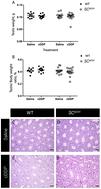当前位置:
X-MOL 学术
›
Toxicol. Res.
›
论文详情
Our official English website, www.x-mol.net, welcomes your
feedback! (Note: you will need to create a separate account there.)
Mice with a Sertoli cell-specific knockout of the Ctr1 gene exhibit a reduced sensitivity to cisplatin-induced testicular germ cell apoptosis.
Toxicology Research ( IF 2.2 ) Pub Date : 2019-11-08 , DOI: 10.1039/c9tx00142e Rashin Ghaffari 1 , John H Richburg 1, 2
Toxicology Research ( IF 2.2 ) Pub Date : 2019-11-08 , DOI: 10.1039/c9tx00142e Rashin Ghaffari 1 , John H Richburg 1, 2
Affiliation

|
Exposure to the chemotherapeutic agent cis-diamminedichloroplatinum(II) (cDDP) is well known to instigate acute and prolonged testicular injury in male patients. Many investigators have hypothesized that cDDP-induced dysfunction of Sertoli cells (SCs) may, in part, account for the cDDP-induced lasting testicular injury. Nevertheless, the relative contribution of cDDP-induced SC injury versus direct effects on germ cells (GCs) to the pathogenesis of GC loss remains to be elucidated. The expression of the copper transporter 1 (CTR1) protein in cells directly corresponds with cDDP uptake and its cellular toxicity. Therefore, to discern the role of SCs in the pathogenic mechanism, mice were developed with a SC-specific disruption of the Ctr1 gene (SCΔCtr1) as a strategy to prevent their exposure to cDDP. Adult mice at postnatal day (PND) 60 were treated with 5 mg kg−1 cDDP and then testis collected at 48 hours. A two-fold increase in GC-apoptosis occurred in the testis of cDDP-treated wildtype (WT) mice as compared to saline-treated WT mice. In contrast, cDDP-treated SCΔCtr1 mice exhibited only a half-fold increase in GC-apoptosis as compared to the saline-treated SCΔCtr1 mice. This reduced incidence of GC apoptosis in the SCΔCtr1 mice corresponded to a significantly lower level of platinum within the testis. Taken together, these findings reveal that the uptake of cDDP by CTR1 in SCs accounts for the accumulation of cDDP in the testis and plays a pivotal role in the pathogenic sequence of events leading to the loss of germ cells via apoptosis.
中文翻译:

具有Sertoli细胞特异性敲除Ctr1基因的小鼠对顺铂诱导的睾丸生殖细胞凋亡的敏感性降低。
众所周知,化学疗法药物顺式-二甲基二氯铂(II)(cDDP)的接触可引起男性患者急性和长期睾丸损伤。许多研究者假设cDDP诱导的支持细胞功能障碍(SCs)可能部分解释了cDDP诱导的持久性睾丸损伤。尽管如此,cDDP诱导的SC损伤与对生殖细胞(GCs)的直接影响对GC丧失的发病机理的相对贡献仍有待阐明。铜转运蛋白1(CTR1)蛋白在细胞中的表达直接与cDDP摄取及其细胞毒性相对应。因此,为了辨别SCs在致病机制中的作用,开发了具有Ctr1的SC特异性破坏的小鼠基因(SC Δ CTR1),其为策略,以防止其暴露于顺铂。用5 mg kg -1 cDDP处理出生后第60天的成年小鼠,然后在48小时收集睾丸。与盐水处理的WT小鼠相比,cDDP处理的野生型(WT)小鼠的睾丸中GC凋亡增加了两倍。相反,顺铂处理的SC Δ CTR1相比于盐水治疗的小鼠显示出仅在GC-凋亡的半倍增加SC Δ CTR1小鼠。这种降低的GC的发生率凋亡在SC Δ CTR1小鼠对应于睾丸内铂的水平明显降低。总之,这些结果显示,顺铂在南海摄取CTR1占顺铂在睾丸积累和起着事件导致生殖细胞的丧失致病序列中的关键作用,通过细胞凋亡。
更新日期:2019-11-08
中文翻译:

具有Sertoli细胞特异性敲除Ctr1基因的小鼠对顺铂诱导的睾丸生殖细胞凋亡的敏感性降低。
众所周知,化学疗法药物顺式-二甲基二氯铂(II)(cDDP)的接触可引起男性患者急性和长期睾丸损伤。许多研究者假设cDDP诱导的支持细胞功能障碍(SCs)可能部分解释了cDDP诱导的持久性睾丸损伤。尽管如此,cDDP诱导的SC损伤与对生殖细胞(GCs)的直接影响对GC丧失的发病机理的相对贡献仍有待阐明。铜转运蛋白1(CTR1)蛋白在细胞中的表达直接与cDDP摄取及其细胞毒性相对应。因此,为了辨别SCs在致病机制中的作用,开发了具有Ctr1的SC特异性破坏的小鼠基因(SC Δ CTR1),其为策略,以防止其暴露于顺铂。用5 mg kg -1 cDDP处理出生后第60天的成年小鼠,然后在48小时收集睾丸。与盐水处理的WT小鼠相比,cDDP处理的野生型(WT)小鼠的睾丸中GC凋亡增加了两倍。相反,顺铂处理的SC Δ CTR1相比于盐水治疗的小鼠显示出仅在GC-凋亡的半倍增加SC Δ CTR1小鼠。这种降低的GC的发生率凋亡在SC Δ CTR1小鼠对应于睾丸内铂的水平明显降低。总之,这些结果显示,顺铂在南海摄取CTR1占顺铂在睾丸积累和起着事件导致生殖细胞的丧失致病序列中的关键作用,通过细胞凋亡。










































 京公网安备 11010802027423号
京公网安备 11010802027423号